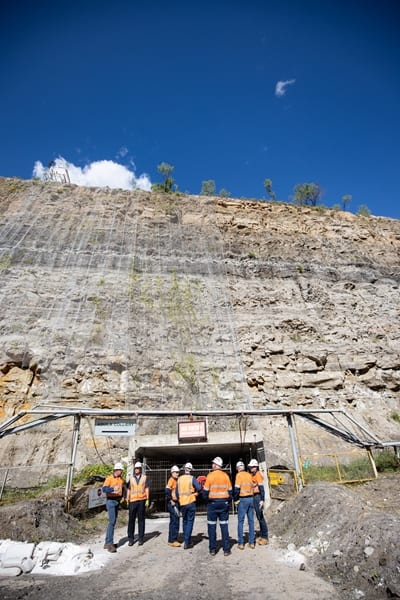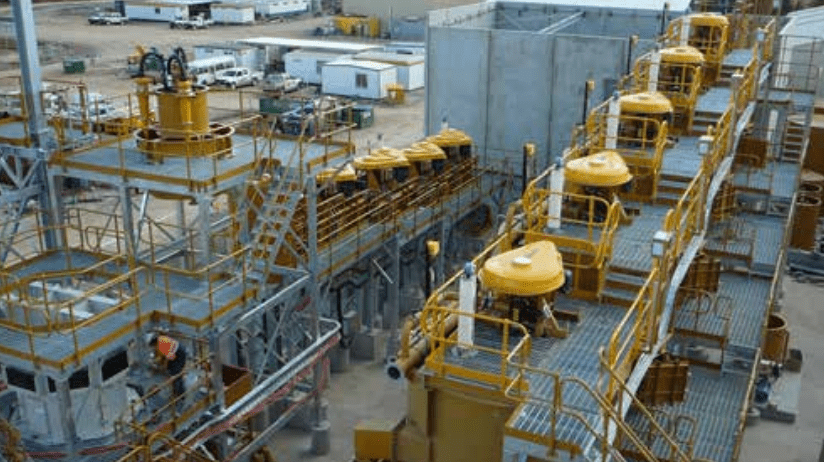1 | Anglo American, Capcoal coal mine, Queensland, Australia
British mining company Anglo American has just started work in Australia on what it envisions as “one of the most technologically advanced underground mines in the world”. It is pumping $226 million into the expansion of an underground coal mine in Queensland’s Bowen Basin, near Middlemount.
The new Aquila expansion will extend the life to 2028 of its existing Grasstree underground operations at its Capcoal complex, which also comprises an open cut mine. Production from the new Aquila site will start in early 2022, with the Grasstree workforce migrating to Aquila as production starts.
The work also goes alongside digital transformation of the existing Capcoal site, which stretches to the size of Lower Manhattan, to optimise capacity and bring higher levels of automation and intelligence to operations.
Anglo American has been rolling out ‘pervasive sensing’, under its FutureSmart Mining initiative, to bring sensors and analytics into the mining arena. It has worked on the project with UK based tech company Silixa to deploy distributed sensing using a single fibre optic circuit, several kilometres long, to enable real-time metering of mine water flows across multiple points in the Capcoal complex.
It is also deploying tablet devices, the first certified for underground mining in Australia, in the Grasstree mine, following initial deployments at its Moranbah North Mine, another underground metallurgical coal mine, also in Australia’s Bowen Basin. Anglo American said it is moving towards “rapid deployment” across all its underground sites.

The tablets, developed with manufacturer Bartec and certified by Queensland’s Safety in Mines Testing and Research Station (SIMTARS), capture and share real-time production, safety and environmental data. The idea is to make critical info available to key personnel, and provide direct access to the company’s safety management system.
Around 400 statutory reports and 2,500 maintenance work orders are generated each week at the Moranbah North Mine, it says. The company wants its mining operations to be paperless within two years. Tablets can also be used for Skype calls with ground-level staff to help with trouble-shooting and emergencies.
The introduction of underground tablets follows “significant” work also on automating longwall operations and digitising the company’s mines, it says. Anglo American recently completed its first pilot longwall shear from an above-ground remote operating centre at its Grosvenor Mine, part of the Moranbah North complex.
Tyler Mitchelson, chief executive at Anglo American’s metallurgical coal business, said: “We will pursue remote operation of the Aquila longwall, ensuring our people are removed from harm’s way, and the continued digitisation of our operations, using new technologies such as our Australian-first intrinsically safe underground electronic tablets. The accelerating pace of technological innovation, particularly in the digitalisation, automation and artificial intelligence areas, are opening up opportunities for the mining sector to be safer, more productive and sustainable.”
2 | Rio Tinto, Kennecott copper mine, Utah, United States
Rio Tinto’s Kennecott mine outside Salt Lake City, in Utah, is the second largest copper producer in the United States, currently providing around 25 per cent of all US copper. It also produces molybdenum, gold, and silver.
Rio Tinto calls Kennecott a “fully integrated” operation. The site comprises the Bingham canyon mine, a concentrator plant, a smelter, and a refinery. Ore from is concentrated into slurry, piped for smelting process, and conveyed to the refinery.

The company has worked with GE Digital to pull data from its various operational and enterprise silos – from operator rounds, maintenance management systems, accounting tools, and process historians – for some time; it was an early partner of GE Digital.
The partnership has seen Kennecott gain better visibility across the entire operation, says GE, allowing for the implementation of new asset management strategies to collect equipment data at the edge, and consolidate it in the cloud. Operators have access to data about the health of mining assets across the site, it says.
But, arguably, its most impressive work with sensors and data has been to connect its conveyor belts, separately of its core data integration work with GE. Mines run conveyor belts like arteries, moving equipment and materials between the mine shaft and the processing plants. Belts can be several miles long, and active for 24 hours per day.
Their maintenance, which has traditionally required manual inspections along their entire length, is vital to the success of the mine. For every 10 feet of conveyor, there are 14 bearings – on a 10 mile belt, the number of potential maintenance issues adds up. If not detected early, the impact of a break or line failure can halt production for hours, and even days.
Transco Industries, a leader in conveyor design and maintenance, has implemented a low-power wide-area (LPWA) solution for Rio Tinto’s conveyor belt applications, and since with other mining companies. Sensors connect to a private LoRaWAN network to allow for the continued relay of real-time data in the mine, and to determine potential breaks.
Sensors are embedded into the belt itself, to measure stress and prevent potential ripping. In the event of a belt rip, the sensors transmit a signal to the belt’s remote control location, immediately shutting it down so that there is no hazardous and expensive tear in the line.
An alert system notifies when a potential bearing is at increased risk for failure, so a technician can be dispatched to attend to the bearing. In some cases, additional sensors have been placed on belt idlers to measure the temperatures of bearings, to prevent overheating and fires.
The distance between the sensors and the analytics server can be up to 30 miles, making LPWA technologies ideal; the absence of mains power also precludes standard cellular or Wi-Fi based devices. In the Kennecott case, data from battery-operated sensors is transferred over a reliable connection and analysed in a cloud-based server.
Marc Pégulu, vice president of IoT at Semtech, the company behind the LoRa standard, says: “Currently-deployed LPWA conveyor sensors are just the first step in this process. The flexibility, long range and low power features within these sensors leads the industry to new, unique implementations.”
3 | Aurelia Metals, Hera-Nymagee gold mine, New South Wales, Australia

The great challenge with the application of data analytics in mineral processing, as with all industrial setups, is to get the operational data out of the system securely. Through 2016, Australian firm Convergio worked with Aurelia Metals, based in New South Wales, to optimise its Hera-Nymagee plant and improve its gold recovery, which was running at 74.6 per cent.
The first step was to join the plant’s information (IT) and operational technology (OT) systems, without putting critical data or functions at risk. Convergio deployed OSIsoft’s PI System as a “demilitarised zone” between the two systems. “PI makes data available to everyone in a way that won’t blow up the plant if someone does something silly,” says Gavin Strack, executive director at Convergio.
Before PI, the process to retrieve operational data was labour intensive, and the data was unreliable. “The peculiarities of the system meant data changed, depending on the volume requested, and the period concerned. Worse, it was not always there. “It kept it for a couple of months, and was gone.”
Without data, Aurelia was reliant on intuition and experience. PI gave it new power, by retaining every data point, and making it available in high resolution, in any format. “It isn’t a trailblazer or a revolutionary, but it now has the means to be.”
Over four quarters, Convergio put in place a series of data modelling techniques across four processes at the Hera-Nymagee plant, starting with the grinding circuit, which smashes up rocks from the mine, mixes in water, and turns them into a slurry. The challenge is the rocks are football-sized, and the gold is like sand.
“The grinding circuit has the biggest impact on the bottom line. Forty per cent of the value you get, between the rock and the gold bar, comes in the refinery, and a big chunk of that is in the grinding circuit,” explains Strack. PI gave Aurelia clearer sight of its performance.
Convergio built a simulation, looked at its production techniques, and played with the numbers. “We validated our assumptions. The last thing you want to do is test it on a real plant and break something.“ It re-ran the validation with the new PI data, and installed a team to keep watch. “One of the idiosyncrasies of process control is you can tune, and tweak, but in six months’ time, it will be running like a dog again,” says Strack.
Assets wear, and have to deal with different dirt from different parts of the mine. “It takes constant adjustment.” By the end of the first quarter, after the grinding circuit optimisation, gold recovery was up 6.6 per cent, to 81.2 per cent. Convergio switched its attention to the flotation circuit, a “series of bubble baths in a daisy chain”; the first are called ‘roughers’ and are the least discriminatory.
He explains: “Some of the bad stuff goes in with the good. It’s like a 100 pound gorilla; it smashes it all up and gets as much out as it can.” The bubble baths perform best with a steady layer of bubbles on the top, says Strack. Peak-to-peak variation in the bubbles went from 110mm to just 30mm, and gold recovery hit 83.9 per cent at the end of the second quarter, a further rise of 2.7 per cent.
But the gold, at this stage, is still in a slurry. The only way to get the gold out of the mulch is to dissolve it in cyanide, which is added to the mix in a leech circuit. Again the challenge is to control the levels. Too little cyanide, and the gold does not come out; too much, and it gets wasted, and has to be neutralised. “You don’t want to dump that in the river.”
The process of neutralising cyanide is costly. Before Aurelia got a grip of its data, its upper and lower cyanide limits were far removed, by as much as 650 parts-per million (PPM). By the end of the third quarter, variability was down to 85 PPM, and gold recovery was 84.3 per cent, up 0.4 per cent.
The last phase focused on the filter press at the end of the refinery line, comprising hydraulic rams that squeeze the gold-bearing moisture out between huge metal plates. “They’re like great big accordions,” says Strack. “You’re left with a dry cake, and a liquid. The cake is barren of any good material. The solution has all the dissolved goodies.”
That’s the theory anyway. When the press goes out of tune, the ‘goodies’ get left in the cake. Worse, if the filter is not cleaned properly, the gold becomes tainted, and the line operators at the mint are put at risk of lead poisoning. Producers can be fined by smelters. Costs deepen if the presses run ragged.
Aurelia’s mines also produce a silver-lead-zinc deposit; any gold left in the cake is sold to China as part of this polymetallic concentrate. “There are no contract provisions for gold in the sale,” explains Strack. “It means China gets any gold in the concentrate for free – for no reason, except your plant’s not working properly.”
The trick with the filter press, again, is to adjust the levels – in this case, of the oscillating hydraulic rams. “Imagine every time the accordion is squashed together, gold falls out the bottom. You want strong, slow, steady squeezes, and not lots of mini squeezes.”
The filter-press oscillations went from peak-to-peak variations of 450kPa at the start of the project to just 20kPa at the end. At the close of the fourth quarter, Aurelia’s gold recovery rate was 88.6 per cent, up 4.6 per cent in the period, and 14 per cent in the year. The company’s debt was down and its share price was up.
